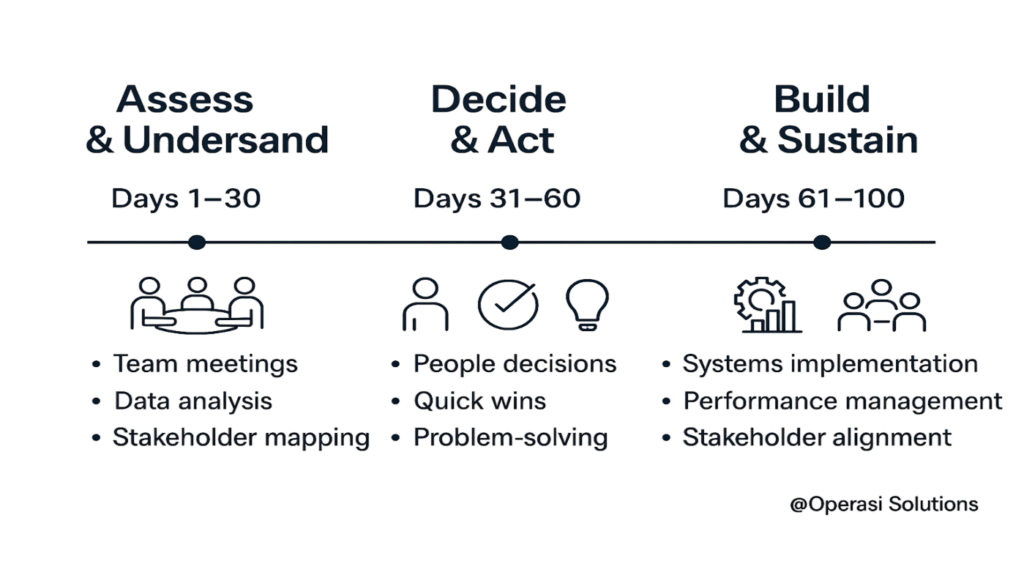The 100-Day New CEO Transition Plan: Your Blueprint for Leadership Success
A Fortune 500 executive’s proven framework for establishing credibility, building momentum, and delivering transformation results in your critical first months as CEO.
The leadership transition is official. You’re now the CEO.
Then reality hits hard.
You’ve got a business to decode, a leadership team to evaluate, stakeholders breathing down your neck, and owners expecting results yesterday. Meanwhile, everyone’s watching to see if you can actually deliver on the promises that got you hired.
As someone who climbed from a $5.50/hour factory job to leading global operations spanning $15M to $13B enterprises, I’ve learned that the first 100 days as CEO determine whether you’ll spend your entire tenure playing catch-up or building lasting competitive advantage.
Here’s what most leadership consultants won’t tell you: success in those first 100 days isn’t about having the perfect strategy. It’s about building decision-making processes that work when everything’s on fire.
Where New CEOs Go Wrong
Three patterns destroy promising leadership transitions:
Analysis Paralysis
Some get stuck gathering information without making decisions. CEO roles require good judgment with incomplete data, not perfect information. I’ve watched brilliant executives fail because they needed one more report when the market demanded action.
Hope as a Strategy
Early in my career, I thought I could coach an underperforming executive into success. Six months later, I realized the cost—missed results and damaged team morale. When economic downturn eliminated volume overnight, I learned that addressing reality quickly builds trust rather than destroying it.
Underestimating Change Requirements
When I implemented advanced inspection systems across our network, technology was only half the challenge. We had to retrain teams, redesign workflows, and work with regulators. Organizational change took as much effort as the technical solution.
What Actually Works in Your First 30 Days: A Blueprint for Leadership Success
Forget the corporate theater. You need to understand what really drives the numbers, not what makes leadership comfortable.
Skip the Polished Presentations
When I took over a large operational division, the initial briefings painted everything as steady. But digging into actual data revealed our processes were years behind competitors and costs were climbing faster than revenue. That ground truth—not the marketing version—became my foundation.
Sit down with each leadership team member individually. Ask what’s really working, what’s broken, and what keeps them up at night. Listen for what they’re not saying. The gaps tell you more than the presentations ever will.
Find Your Real Performance Levers
Most businesses have 3-5 metrics that control 80% of results. Your job is finding them fast.
Don’t get buried in dashboards. Focus on numbers that require action when they move. I learned this when everyone obsessed over production volume while the real opportunity was fixing supply chain bottlenecks.
Build Your Operating Rhythm Early
Figure out communication patterns that match how you actually work. Some CEOs want daily updates. Others prefer weekly deep dives. The key is consistency and focusing on information that drives decisions.
Days 31-60: Making the Hard Calls
Month two separates fantasy from reality. Here’s what most executives struggle with:
Make People Decisions Fast
By now you know who gets it and who doesn’t. The executives who can adapt to what you need, and those stuck in old ways.
I once inherited a leadership team that looked perfect on paper but couldn’t handle change. The operations leader who “knew the business” was doing everything manually while competitors went digital. Waiting for him to “come around” wasn’t leadership—it was wishful thinking.
Making personnel changes early isn’t personal. It’s math. Every day you delay costs momentum you can’t recover.
Start Fixing Obvious Problems
Pick things you can improve within the quarter without massive capital approval. Focus on stuff that’s clearly broken and within your control.
When I led digitalization across multiple manufacturing plants, we started with basic operational improvements that showed quick results. Those wins built credibility for bigger technology investments later.
The key is parallel execution—quick wins proving you can deliver, plus longer-term capability building that creates real advantage.
Days 61-100: Building Sustainable Systems for Leadership Success
Your opening months establish credibility that defines your entire tenure. Five elements need attention simultaneously:
- Get ruthlessly specific about success. Replace vague transition objectives like “build the team” with concrete targets: “Complete leadership assessment, make necessary personnel changes, and establish weekly performance rhythm generating measurable results by day 90.”
- Force genuine alignment upfront. Hash out resource conflicts and priority trade-offs with your board and leadership team before implementation begins. Surface disagreements early, not through passive-aggressive organizational warfare later.
- Build execution rhythm. Daily leadership touchpoints. Weekly performance reviews. Monthly board updates. Consistent rhythm creates momentum and surfaces problems before they become crises.
- Make accountability everyone’s job. Whether through existing performance frameworks or new systems, embed follow-through into organizational DNA. Make keeping commitments part of company culture from day one.
- Model the behavior you expect. When you show up prepared, follow through on promises, and adapt when circumstances change, the entire organization mirrors that discipline.
This is where the Blueprint for Leadership Success shifts from survival to sustainable growth.

Why Getting This Right Matters More Than Ever
In private equity environments, every delayed quarter erodes returns and partner confidence. In public companies, weak transitions invite activist investors or regulatory scrutiny. Boards increasingly demand proof you can deliver results, not just articulate vision.
The leaders who thrive understand that having leadership potential isn’t the competitive advantage anymore. Systematic transition discipline is. With a Blueprint for Leadership Success, CEOs can prove value quickly and build long-term credibility.
Our Approach to CEO Transition Excellence
At Operasi Solutions, we tackle CEO transitions through four integrated capabilities:
Transition Acceleration: Converting leadership potential into systematic decision-making capability that works under pressure and uncertainty.
Team Performance Assessment: Rapidly evaluating inherited talent and building high-performing leadership teams aligned with transformation requirements.
Stakeholder Alignment: Managing complex relationships while implementing necessary changes that drive measurable business results.
Operational Excellence Integration: Leveraging proven frameworks and digital tools to accelerate decision-making without adding organizational complexity.
Our P.E.A.K. framework and Summits of Leadership methodology emerge from years of leading transformations where execution discipline determined market position and competitive advantage.
Questions Leaders Ask About CEO Transitions
1. What should new CEOs prioritize in their first month?
Focus on business reality assessment, leadership team evaluation, and building performance management rhythms. Avoid trying to make everyone happy—focus on understanding what actually drives results.
2. How do you evaluate inherited leadership teams quickly?
Assess each leader’s ability to execute at required pace, adapt to necessary changes, and develop their teams. Document observations and make personnel decisions within 60 days maximum.
3. What’s the biggest mistake new CEOs make?
Spending too much time gathering information without making decisions. CEO effectiveness requires good judgment with incomplete data, not perfect analysis.
4. How do Fortune 500 executives transition to CEO roles successfully?
They combine their operational expertise with systematic approaches that develop personalized decision-making frameworks. The best transitions integrate proven methodologies with customized approaches for specific organizational contexts.
5. When should new CEOs seek transition support?
Immediately. The most successful transitions combine operational experience with structured approaches that help develop systematic leadership capabilities. This isn’t about fixing problems—it’s about building capabilities that generate consistent results.
6. How long should CEO transitions take?
Establishing credibility and momentum requires the full 100 days, but key decisions about people and priorities should happen within the first 60 days. Anyone who says they can assess everything in 30 days probably doesn’t understand organizational complexity.
The Leadership Advantage
Organizations with leaders who master systematic transition approaches respond faster to market changes, allocate resources more effectively, and build capabilities that strengthen over time.
More importantly, they develop leadership teams capable of translating any sound strategy into measurable business results—the capability that boards, investors, and stakeholders value most in today’s environment.
At Operasi Solutions, we believe your first 100 days as CEO determine whether you achieve your full potential as a transformational leader. That’s why we built our Blueprint for Leadership Success to help executives transition with confidence, clarity, and measurable results.
